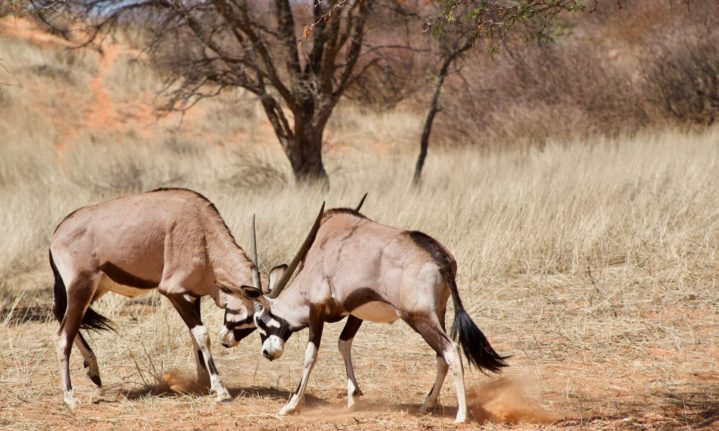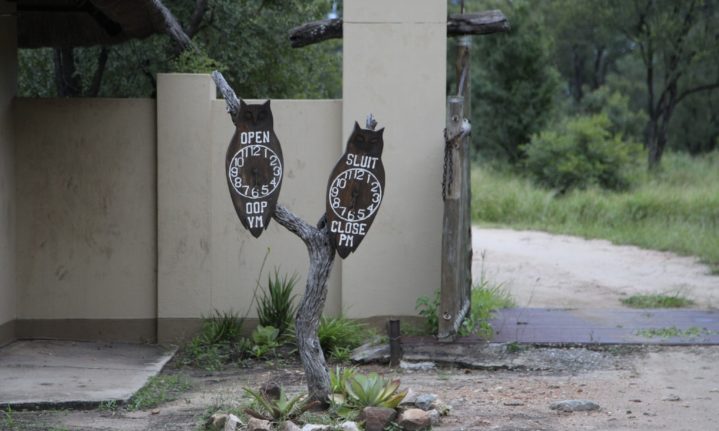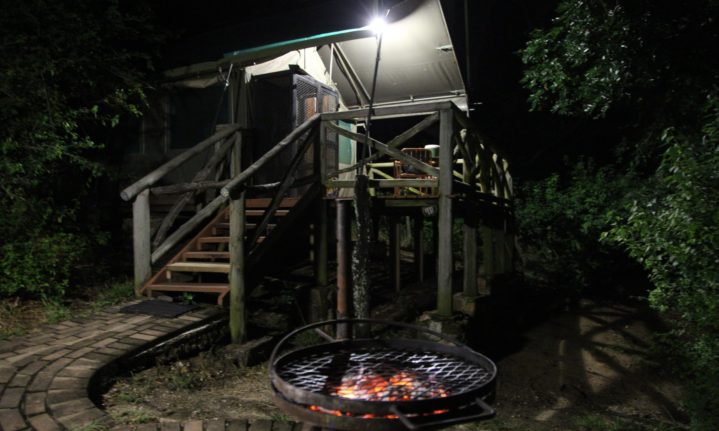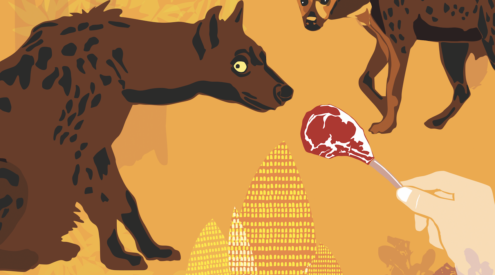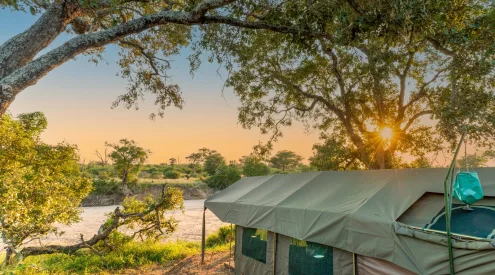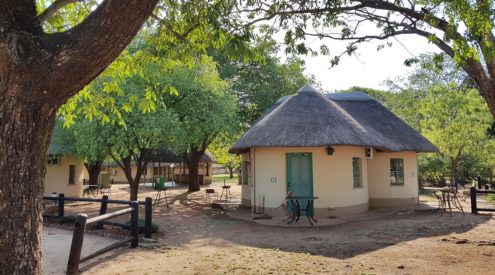Weighing in at 3,8 million ha and 2 million ha respectively, the Kgalagadi Transfrontier Park and the Kruger National Park are top of many a South African’s favourite parks list. Each park offers unique wilderness and incredible game viewing, but a visit to the Kgalagadi is vastly different to a visit to the Kruger.

We pit two of our biggest and most loved parks against one another in this breakdown of accommodation, climate, roads, accessibility, game-viewing and cost.
Roads
The main difference between roads in the parks is that no part of the Kgalagadi is tarred, while Kruger has a combination of tarred and dirt roads. This makes Kruger much easier to traverse, even in low clearance vehicles with no 4×4 capability. The Kgalagadi on the other hand should not be attempted in anything that doesn’t have some height, and ideally some low range capability. While the roads do get graded, the corrugations and thick sand make travelling in a low car tricky. Plus, it’s easier to spot game when you have a bit of height.
There are 4×4 routes in the Kgalagadi, but these are designed to be driven one way only for a limited number of vehicles, and must be pre-booked at the camps. Only guests staying at Bittterpan and Gharagab wilderness camps are permitted to use the 4×4 routes, and trailers may not be towed on these routes. The network of roads in the Kgalagadi is limited because of the sand dunes, so during a long stay you’ll find yourself driving the same roads over and over again, like the road leading to Mata Mata for example.
The Kruger has a variety of roads, but is tarred from north to south, linking all the main camps. There are dirt roads that can get a bit muddy in the summer, and there are tracks for 4×4 vehicles only, but they can be attempted without needing permission. There is a vast network of routes within Kruger, with plenty of loops and riverside dirt roads, so you almost never have to drive the same route if you don’t want to.

The Kgalagadi roads are great after they’ve been graded, but after a while the deep corrugations can become impossible to navigate in a sedan.
Accessibility
It is possible to pop in as a day visitor to the Kgalagadi, but it’s not as easy as it is to do in Kruger. There is only one entrance into the Kgalagadi on the South African side, and few towns close enough to allow time to get to the park and self drive for the day. There is also a 20 car per day limit, so you’ve got to book online or get in early if you want to get in. There is a daily conservation fee of R104 per person for SA citizens (R52 for children).
Kruger on the other hand is easier to access, with 10 entrance gates and towns like Hoedspruit, Phalaborwa, Hazyview and Komatipoort close to the park, it’s easy to go in and self drive for the day. There is usually no cap on the number of day visitors, except under certain levels of lockdown. There is a daily conservation fee of R110 per person for SA citizens (R55 for children).

Phalaborwa Gate. With 10 access gates, a day trip to the Kruger is an option for many people living near its borders.
Accommodation
There is a range of accommodation in both parks, for all kinds of visitors with all kinds of budgets. There is more variety in Kruger, while there are smaller, more exclusive options in the Kgalagadi. Mata Mata, Twee Rivieren and Nossob could be compared to camps like Kruger’s Letaba or Satara in terms of the self catering accommodation offered, they are just smaller than some of Kruger’s rest camps. In Kruger there are smaller bungalows that have access to communal bathrooms and cooking areas, which are suitable for people on a budget.
Campsites in Kruger and the Kgalagadi are fantastic and are priced similarly. The Kgalagadi has the upper hand here as there are premium campsites in Nossob camp, which have private ablutions, and a shaded catering area with a sink (one per campsite). These cost more than regular camping but as all campers know, private ablutions are a luxury!
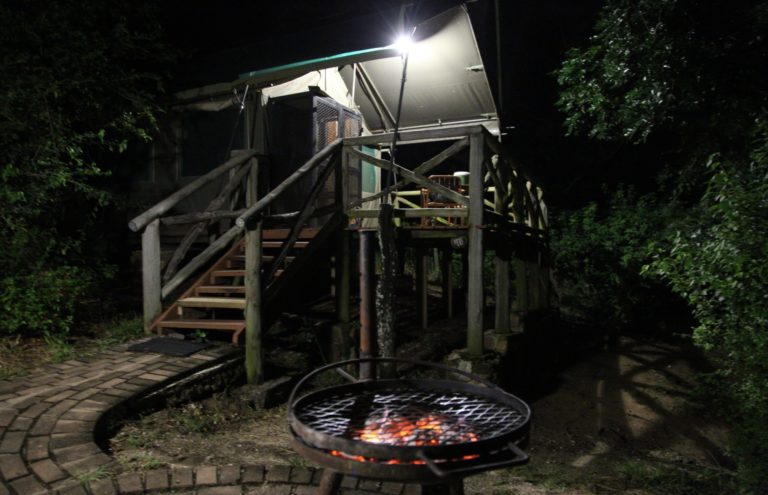
Tamboti in Kruger is a popular bush camp near Orpen gate, as it is affordable and quiet, with views of the Timbavati river.
The Wilderness Camps of Kgalagadi, like Kieliekrankie and Urikaruus, can be compared to the Bush Camps of Kruger, like Talamati or Tamboti, with the added bonus that in the Kgalagadi they are smaller and unfenced. Wilderness camps and bush camps have no shops, restaurants or petrol stations.
In all camps in the Kgalagadi, the electricity goes off for a few hours at night, while in the Kruger power runs continuously.
For those looking for a more luxurious catered option in the Kgalagadi, there is community owned !Xaus Lodge. Guided game drives and walks are included in the rates.
https://www.xauslodge.co.za/2019-rates
The Kruger and Greater Kruger especially are full of luxury options for visitors looking to be spoiled.
Game
While there is some overlap between game found in Kruger and game found in the Kgalagadi, each park offers their own unique species. You could think of the Kruger as the impala park and the Kgalagadi as the springbok park!
The Kgalagadi is home to around 60 species of mammal while Kruger is home to around 140 different mammals.
Kruger is famous for its Big Five, but the Kgalagadi has its own interesting array of species that excite visitors just as much. Brown Hyenas, (also found in Kruger but rarely seen) bat eared foxes and black maned Kalahari Lions are special sights, as well as oryx (gemsbok) which are not found in Kruger.
READ: Kruger by Numbers: the statistics that make up the beloved Park
In some ways, it is easier to spot things in the Kgalagadi as there is less vegetation and most routes are along sparse riverbeds. However, a pair of binoculars is essential as animals like cheetah sleep beneath camel thorn trees a few hundred metres from the roads. The same could be said for Kruger, and although the game density is much higher there, the vegetation in parts is much thicker and can make game viewing difficult.
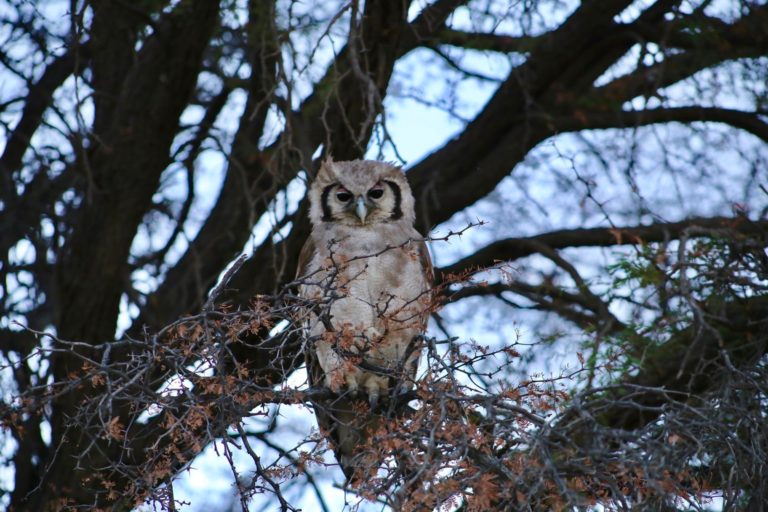
A Verreaux’s Eagle Owl near Twee Rivieren in the Kgalagadi. A day time sighting like this would be hard to come by in the Kruger.
The wilderness camps in the Kgalagadi are unfenced, while no SanParks camps in Kruger are unfenced. (There are some unfenced camps in Greater Kruger). So game viewing continues within the Kgalagadi camps sometimes! On the Botswana side of the Kgalalgadi, it’s not uncommon to spot lions resting in the shade of the A-frame campsites. The raised decks at Kalahari tented camp have now had mesh put around them as lions and other predators tended to gather in the shade beneath the decks.
Birding in both the Kruger and Kgalagadi is incredibly rewarding, and while Kruger may be home to over 500 species of birds, if it’s close encounters with raptors and owls you’re after then the Kgalagadi is the place. spotted eagle owls, Verreaux’s eagle owls, barn owls and pearl spotted owls perch, nest and snooze in camel thorn trees all along the main roads, while raptors like pale chanting goshawks and black chested snake eagles, pygmy falcons and martial eagles spend days hunting for the many rodents and small birds that also call the Kgalagadi home.
Shops
The shops are much better stocked in Kruger. You can get anything from fresh produce and meat, to hand crafted gifts, to kitchen utensils to jewellery and everything in between. It’s possible to arrive in Kruger with no groceries and still be able to self cater, provided you’re staying at one of the rest camps and not a bush camp. Kruger’s main rest camps like Letaba, Satara and Skukuza all have restaurants should you not want to self cater, while in the Kgalagadi the only option is Twee Rivieren’s restaurant.
In Kgalagadi shops, the offerings are limited. You may find a bag of onions or potatoes here and there, and at Mata Mata you can order freshly baked bread, but it’s better not to rely on the shops for groceries. These shops have also been known to run out of ice so make sure you have plenty!
Read: The Ultimate guide to self-catering in the Kgalagadi
Numbers
The Kgalagadi may have fewer roads, less game and fewer camps but that means fewer visitors, too. While the South African section of the park is less than half the size of the Botswana side, it is still so vast that visitors can often drive for ages without encountering another vehicle. There is less competition for sightings, less congestion on the roads and the camps are much quieter which is a big plus for the Kgalagadi.
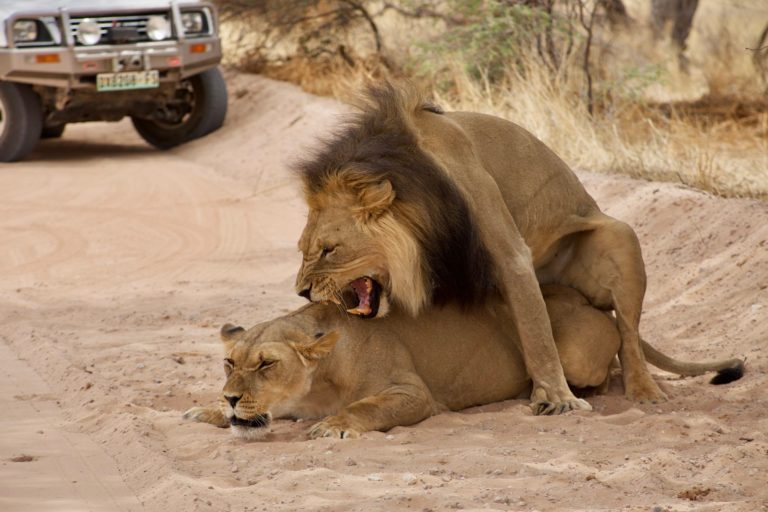
Mating lions in the road, Kgalagadi. A sighting like this would attract loads of traffic in the Kruger.
Climate
While the climate changes dramatically in both parks, the Kgalalgadi has more extreme seasons. Daytime temperatures in summer can reach up to 35 °C and above, even topping 40 °C. The winter mornings and nights can get well below freezing, and the daytime winter temperatures can be as mild as 16 °C.
The Kruger of course also reaches extremely high temperatures in summer, also occasionally topping 40 C, but can get much more humid than the Kgalagadi as the rainfall is higher. Winter days are mild, averaging around 24 °C, although mornings and nights can be as cold as 10 °C.

One thing the picnic sites have in common in both parks, is the attraction of pesky birds who attempt to steal food off the tables and braais due to humans feeding them.
Picnic spots
The picnic spots in Kruger and in the Kgalagadi are equally beautiful, but the Kruger has the upper hand in terms of convenience. Kruger picnic sites have attendants that supervise the picnic sites, and rent out skottels for bush breakfasts. In the Kgalagadi, there are no attendants so you must bring all your cooking equipment with you, and you need to take your refuse with you when you leave as there are no dustbins.
Vegetation
Vegetation in the two parks is vastly different. The Kruger has a huge variety of flora, which varies a lot within the park itself. The Kgalagadi has less variety, but both parks have their perks.
In general, because the vegetation is thinner in the Kgalagadi, game is easier to spot. However, the dunes conceal a lot of what goes on beyond the roads, and unless game is congregating in the ancient riverbeds, you could miss out on sightings that are just out of view.
In Kruger, especially in summer, the bush is impenetrably thick and can conceal even elephants in the green overgrowth. In winter, animals with tawny coats blend into the dull veld and can be equally difficult to spot.
Cost
If you compare apples with apples, the Kgalagadi and Kruger accommodation managed by SanParks cost more or less the same for self catering units. Between R2 500 and R3 500 is about the going rate for an air conditioned self catering unit that sleeps 4.
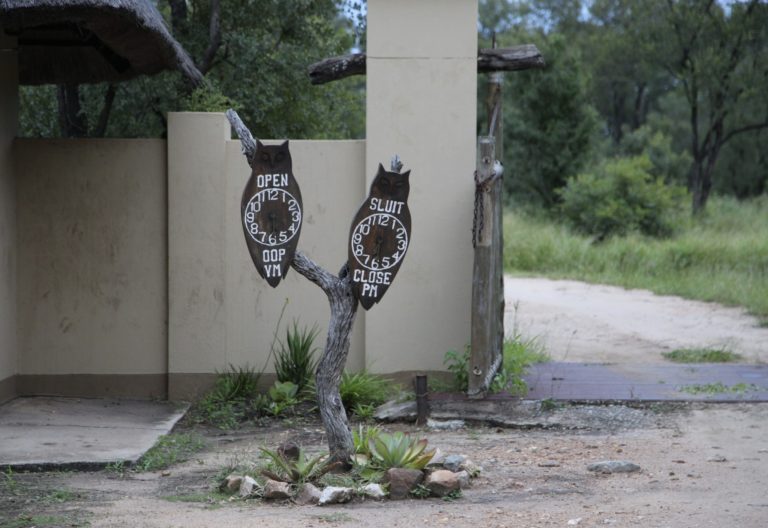
Talamati, Kruger National Park.
Camping rates can also be compared, and will cost no less than R400 per campsite (with a power point for two people) which can accommodate up to six people at an added rate of R100 pp pn.
The luxury lodges have their own prices, but Kruger has more variety in terms of luxury.
ALSO READ
Backpacking the Kruger? What to pack for a three-day walk in the wild












